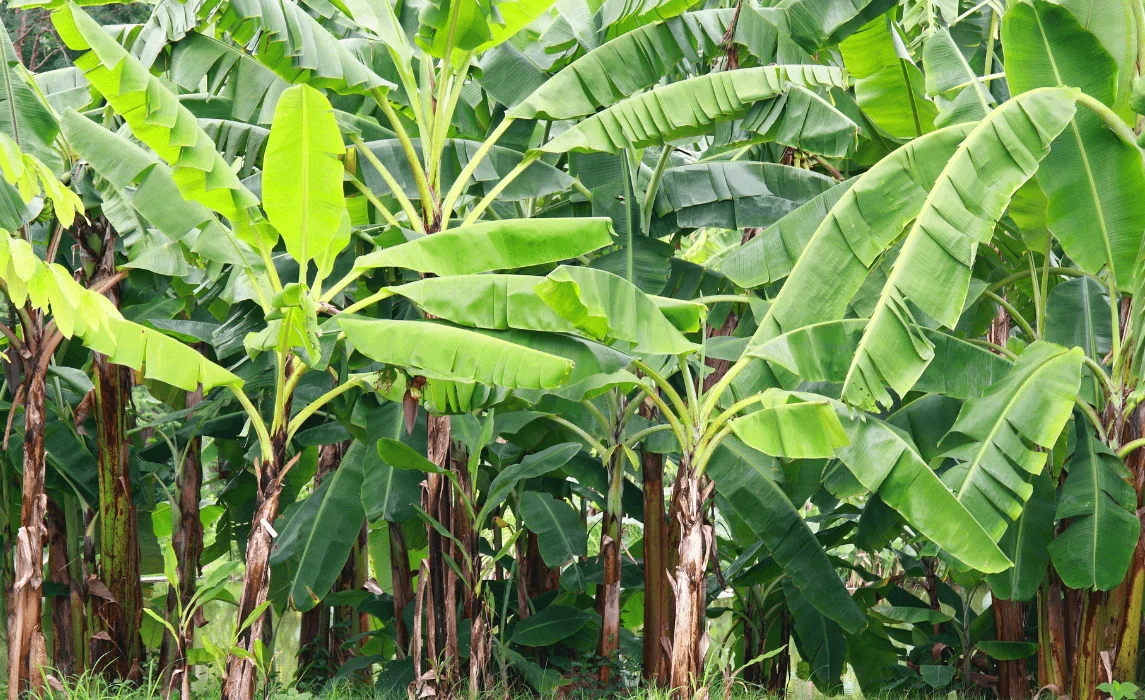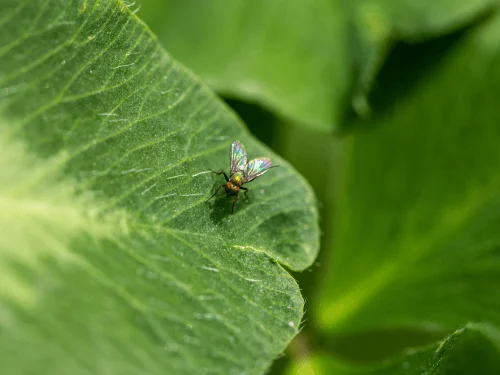How to Grow Kiwi Fruit and Care for a Thriving Kiwifruit Vine
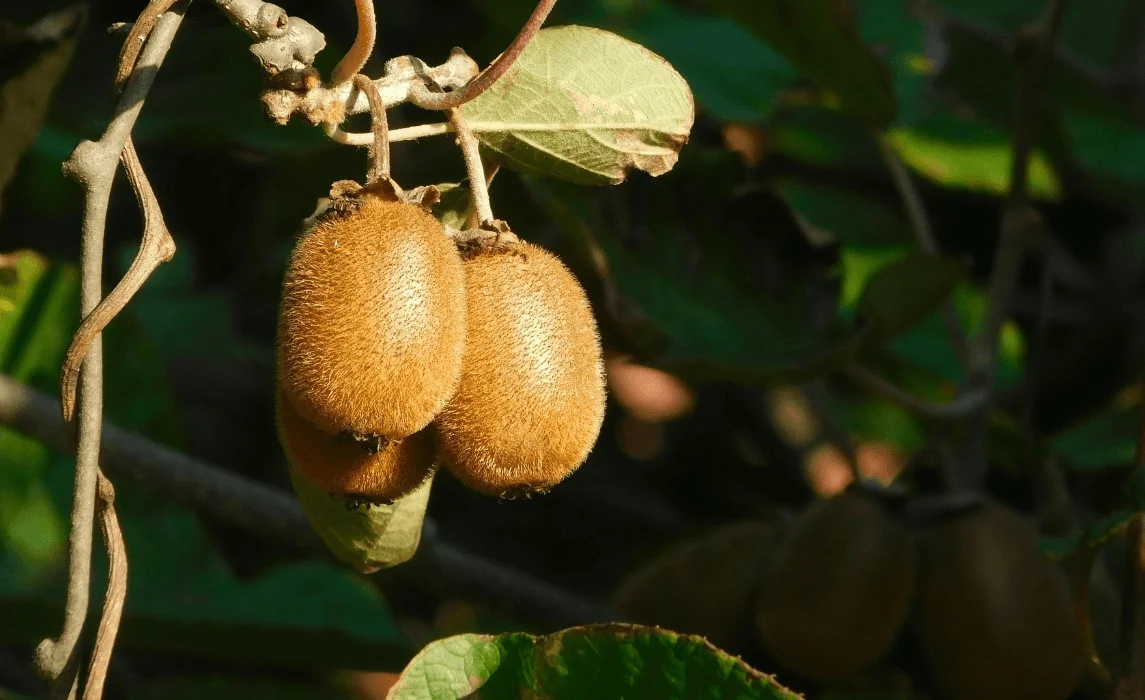
Q1: How can I identify common insects in my garden?
A: Look for signs such as holes in leaves, leaf miner damage, egg clusters, or wilting. Inspect the undersides of leaves, stems, and roots for adults and larvae of moths, sawfly, cabbage looper, tomato hornworm, and European corn borer.
Q2: What natural methods can control pests?
A: Encourage beneficial insects like ladybugs and parasitic wasps, handpick pests, squish caterpillars and slugs, prune infested leaves, and use DIY sprays like neem oil or spinosad. Row covers can also repel moths, sawfly, and cabbage white.
Q3: How can I prevent pests in my garden?
A: Maintain garden hygiene, remove debris, rotate crops, use companion planting, encourage beneficial insects, and inspect leaves and roots for early damage. Row covers and DIY sprays also help prevent infestations.
Q4: How do pests cause plant diseases?
A: Pests spread blight and bacterial wilt through feeding wounds. Early identification, removing infested plants, natural pest control, and healthy soil help minimize disease.
1. Can I grow fruit trees in small gardens or pots?
Yes! Many dwarf fruit trees and container-friendly varieties are perfect for small gardens or patios. Trees in pots can include citrus trees, figs, and dwarf apple trees. Using containers allows you to control soil, water, and temperature more easily, making it possible to grow fruit even in northern climates. These trees are especially useful if you want fast-growing trees that produce fruit within a few years and don’t require a large orchard space.
2. What climate is best for fruit trees?
The climate plays a major role in fruit production. Cold-hardy trees like apples, pears, and plums survive in northern regions, including zone 3, while citrus trees, figs, and peaches thrive in warmer southern areas like Florida or Virginia. Some fruit trees may require protection from frost, while others can tolerate cold winters. Understanding your USDA zone and local conditions ensures your trees will grow healthy and produce fresh fruit consistently.
3. Where can I buy fruit trees online?
Many growers offer fruit trees for sale online, including bare root trees, grafted trees, and container-grown trees. Buying fruit trees online allows you to select from a wide range of fruit tree varieties suitable for your climate, including apples, pears, peaches, plums, citrus trees, and more. When purchasing, check for USDA zone compatibility, tree size, and health guarantees to ensure you receive a quality tree that will thrive in your garden.
1. What is the best way to grow raspberries?
Raspberries grow best when planted in a sunny garden with well-draining soil. You can start by planting bare-root or potted plants in early spring or late fall. Rows of raspberries should be spaced about 2 to 3 feet apart within a row and 8 feet between rows. Using a trellis or support system helps canes grow upright and promotes healthy berry production.
2. How do I plant raspberries?
When planting raspberries, place the crown of the plant 1 or 2 inches above the ground. For bare-root plants, spread the roots in a hole and cover gently with soil. For potted plants, plant at the same depth as they were in the container. Make sure each bush has space to spread so new shoots and suckers can grow without overcrowding. Raspberries are easy to grow, but giving them proper spacing and sunlight ensures your raspberry patch thrives.
3. When do raspberries grow fruit?
Raspberries are perennials, and the first year canes mostly focus on root and cane growth. Summer raspberries (summer-bearing) produce fruit on two-year-old canes, typically in early summer. Fall-bearing raspberries (everbearing) can produce a crop in the fall of the first year, and another in the following summer from the same primocanes. With proper care, a bush can produce fruit in both summer and fall, giving you fresh raspberries for pies, tarts, or eating straight from the garden.
Dreaming of harvesting your own sweet, tangy kiwifruits right from your garden? Growing kiwi fruit from seed is easier than you might think—and incredibly rewarding. With the right care and patience, you can cultivate a lush, fruit-bearing vine that not only produces delicious kiwifruit but also adds a tropical charm to your backyard or patio.
In this guide, you’ll learn everything you need to know about how to grow kiwi fruit from seed—from germination and transplanting to pruning and harvesting. Whether you’re a beginner gardener or an experienced plant enthusiast, these practical tips will help you nurture a healthy, productive kiwifruit vine that thrives season after season.
Types of Kiwi Fruit
There are several kiwi varieties suitable for different climates and garden conditions. Knowing which one fits your environment helps ensure success.
1. Fuzzy Kiwi (Actinidia deliciosa):
The classic supermarket kiwi with brown, fuzzy skin and bright green flesh. It has a tangy-sweet flavor and grows best in mild, frost-free climates with plenty of sunlight. This variety is vigorous and requires a male plant for pollination.
2. Hardy Kiwi (Actinidia arguta):
Produces smaller, smooth-skinned fruits that can be eaten whole. This cold-hardy variety can survive temperatures as low as -25°C (-13°F), making it suitable for cooler regions. The fruits are sweet, aromatic, and often grow in clusters.
3. Arctic Kiwi (Actinidia kolomikta):
The most cold-tolerant variety, thriving in areas with very cold winters. It is valued not only for its small, sweet fruits but also for its striking variegated leaves, which show shades of green, white, and pink, adding ornamental beauty to gardens.
4. Self-Fertile Kiwi (Actinidia deliciosa ‘Jenny’):
A compact, self-pollinating variety that’s perfect for smaller gardens or container growing. It bears medium-sized, fuzzy fruits similar to the common kiwi and doesn’t require a separate male plant, making it easier for home gardeners to maintain.
How to Plant Kiwi Fruit (Step-by-Step)
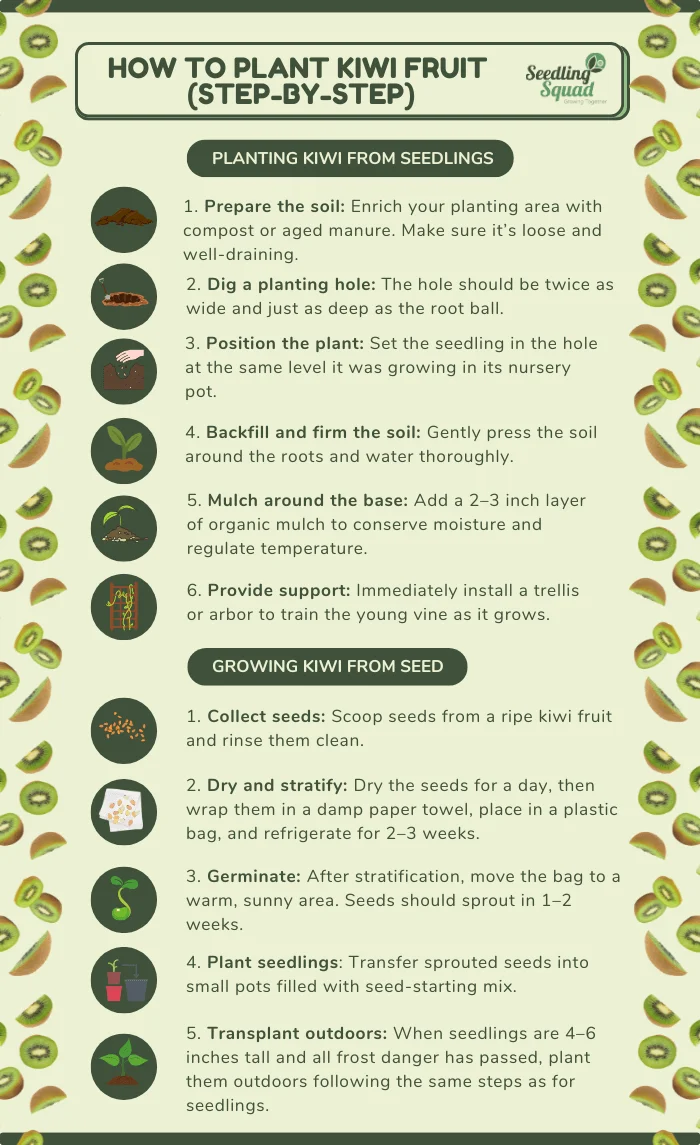
Planting Kiwi from Seedlings
- Prepare the soil: Enrich your planting area with compost or aged manure. Make sure it’s loose and well-draining.
- Dig a planting hole: The hole should be twice as wide and just as deep as the root ball.
- Position the plant: Set the seedling in the hole at the same level it was growing in its nursery pot.
- Backfill and firm the soil: Gently press the soil around the roots and water thoroughly.
- Mulch around the base: Add a 2–3 inch layer of organic mulch to conserve moisture and regulate temperature.
- Provide support: Immediately install a trellis or arbor to train the young vine as it grows.
If planting male and female vines, space them 10–15 feet apart for proper pollination (one male plant can pollinate up to six females).
Growing Kiwi from Seed
Growing kiwi from seed is slower but a fun project. Expect to wait 5–7 years for fruiting.
- Collect seeds: Scoop seeds from a ripe kiwi fruit and rinse them clean.
- Dry and stratify: Dry the seeds for a day, then wrap them in a damp paper towel, place in a plastic bag, and refrigerate for 2–3 weeks.
- Germinate: After stratification, move the bag to a warm, sunny area. Seeds should sprout in 1–2 weeks.
- Plant seedlings: Transfer sprouted seeds into small pots filled with seed-starting mix.
- Transplant outdoors: When seedlings are 4–6 inches tall and all frost danger has passed, plant them outdoors following the same steps as for seedlings.
Kiwi Growing Requirements
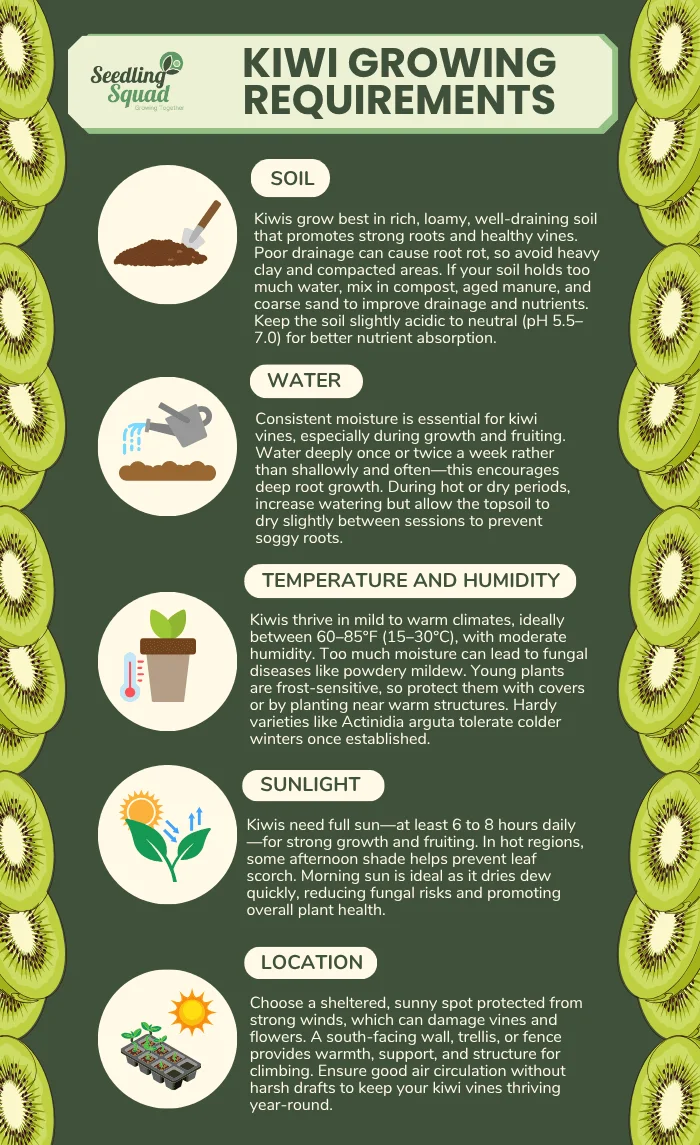
Soil
Kiwis thrive in rich, loamy, and well-draining soil that supports strong root development and healthy vine growth. Poor drainage can quickly lead to root rot, so it’s crucial to avoid planting kiwis in heavy clay or compacted soil. If your garden soil tends to hold water, improve its texture by mixing in organic compost, aged manure, and coarse sand. This not only enhances drainage but also boosts nutrient content, providing the ideal foundation for vigorous kiwi vines. Maintaining slightly acidic to neutral soil with a pH between 5.5 and 7.0 will further ensure optimal nutrient absorption.
Water
Consistent watering is key to growing healthy kiwi vines. The soil should remain evenly moist, especially during the growing and fruiting seasons when the plant’s water needs are at their highest. However, overwatering should be avoided, as soggy soil can suffocate the roots. Deep watering once or twice a week is more effective than frequent shallow watering, as it encourages the roots to grow deeper into the soil. During dry spells or heatwaves, increasing watering frequency may be necessary, but always allow the top layer of soil to dry slightly between waterings to prevent excess moisture buildup.
Temperature and Humidity
Kiwis grow best in mild to warm conditions, with ideal temperatures ranging between 60–85°F (15–30°C). They prefer moderate humidity levels; too much moisture in the air can create favorable conditions for fungal diseases like powdery mildew. Young kiwi plants are particularly sensitive to frost, so it’s important to protect them during cold snaps by using frost cloths, row covers, or by planting them near structures that radiate warmth. Once established, hardy kiwi varieties (such as Actinidia arguta) can tolerate significantly colder winters, making them suitable for temperate regions.
Sunlight
Sunlight plays a vital role in kiwi growth and fruit production. Kiwis require full sun exposure—at least 6 to 8 hours of direct sunlight daily—to ensure vigorous vine development and abundant fruiting. In regions with extremely hot summers, providing light afternoon shade can help protect the foliage from scorching and stress. Positioning the plants where they receive ample morning sunlight promotes faster drying of dew, reducing the risk of fungal issues and promoting healthy growth.
Location
The right planting location can make a significant difference in the success of your kiwi vines. Choose a sheltered area protected from strong winds, which can damage the delicate vines and flowers. A south-facing wall, trellis, or sturdy fence offers both warmth and protection while giving the vines ample structure to climb. Since kiwi plants are vigorous climbers, they need strong support systems to bear the weight of the mature vines and fruit clusters. Planting them in a spot with good air circulation but not exposed to harsh drafts will help maintain a healthy growing environment year-round.
Maintenance Tips for Growing Kiwi
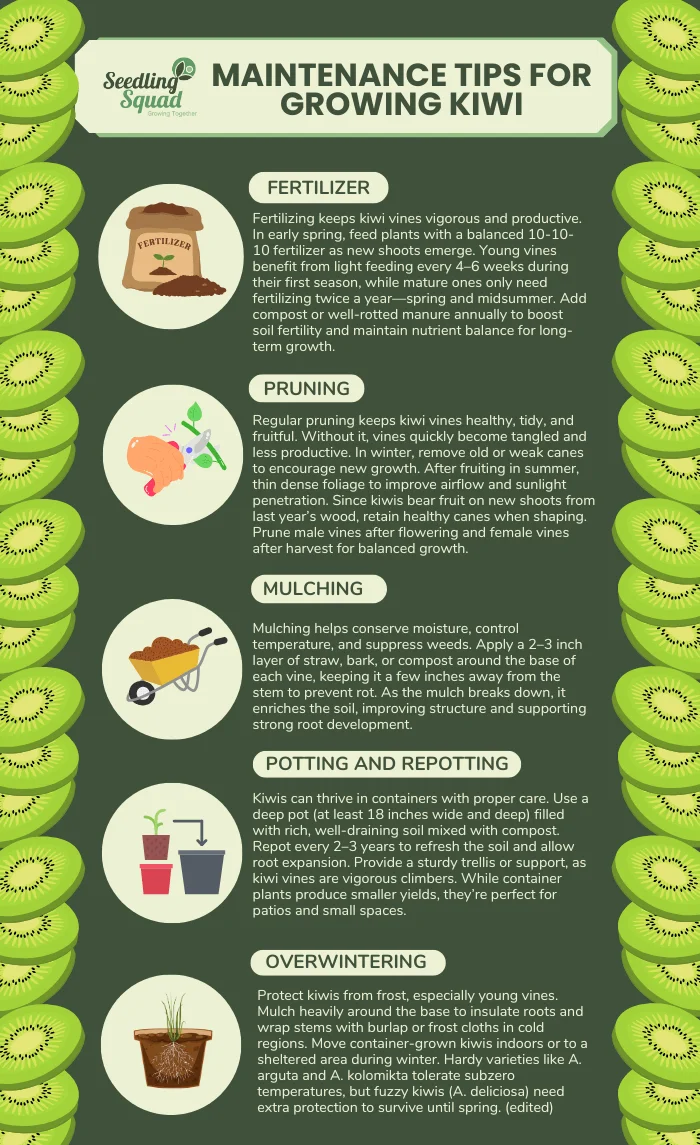
Fertilizer
Proper fertilization ensures that kiwi vines remain vigorous and produce abundant, high-quality fruit. In early spring, as new shoots begin to emerge, feed your kiwi plants with a balanced 10-10-10 fertilizer to provide equal amounts of nitrogen, phosphorus, and potassium. Young plants benefit from light, regular feeding every 4–6 weeks during their first growing season to encourage steady growth without overwhelming their roots. Mature vines, on the other hand, only need feeding twice a year—once in spring and again in midsummer—to support flowering and fruit development. In addition to synthetic fertilizers, enrich the soil each year with a generous layer of compost or well-rotted manure. This natural amendment not only improves soil structure and fertility but also helps maintain the ideal balance of nutrients that kiwis need to thrive season after season.
Pruning
Pruning plays a critical role in maintaining the health, shape, and productivity of kiwi vines. Without regular pruning, the vigorous growth can quickly become tangled and unmanageable, reducing fruit yield and increasing the risk of disease. During winter, when the plants are dormant, prune away old, dead, or weak canes to encourage strong new growth and to shape the vine for the coming season. In summer, after the fruiting period, perform light pruning to thin out dense foliage and improve air circulation and sunlight penetration throughout the plant. This helps prevent fungal problems and ensures that future fruits ripen evenly. Remember that kiwis produce fruit on new shoots that emerge from last year’s wood, so it’s important to retain healthy canes from the previous season. For those growing both male and female plants, prune male vines after flowering and female vines after harvesting to maintain a balanced and productive system.
Mulching
Mulching is one of the easiest yet most beneficial maintenance steps for kiwi plants. Apply a 2–3 inch layer of organic mulch, such as straw, bark chips, or compost, around the base of each vine. This layer acts as a natural insulator, helping to retain soil moisture during dry spells, regulate soil temperature during seasonal changes, and suppress weed growth that competes for nutrients and water. As the mulch decomposes, it also enriches the soil with organic matter, promoting healthier root development. Be sure to keep the mulch about 3 inches away from the main stem to prevent excess moisture from causing rot or fungal issues at the base of the vine.
Potting and Repotting
For gardeners with limited space, kiwi plants can be successfully grown in large containers, provided they receive the right care. Choose a deep container at least 18 inches in diameter and depth to accommodate the vigorous root system. Use a loamy, well-draining potting mix enriched with compost to ensure proper aeration and nutrition. As the plant grows, repot it every 2–3 years to refresh the soil and provide additional space for root expansion. It’s essential to install a strong trellis or support system in the container, as kiwi vines are natural climbers and need structure to grow upright. While container-grown kiwis typically yield smaller harvests compared to those in the ground, they are ideal for patios, balconies, and small gardens where space is limited but beauty and productivity are still desired.
Overwintering
Kiwi plants, especially younger ones, require extra protection to survive cold winters. In regions with harsh climates, begin by mulching heavily around the base of the vine to insulate the roots from freezing temperatures. For young or tender vines, wrap the stems in burlap or frost blankets to guard against frost damage and windburn. If you’re growing kiwis in containers, move them into an unheated garage, shed, or greenhouse during the coldest months to shield them from freezing conditions. Once established, hardy kiwi varieties (Actinidia arguta and Actinidia kolomikta) can endure subzero temperatures with minimal protection. However, fuzzy kiwi varieties (Actinidia deliciosa) are more sensitive and will require additional care during winter to ensure they survive and bounce back strong in the spring.
Common Pests and Diseases
Although generally low-maintenance, kiwi vines can face a few pests and diseases.
Pests
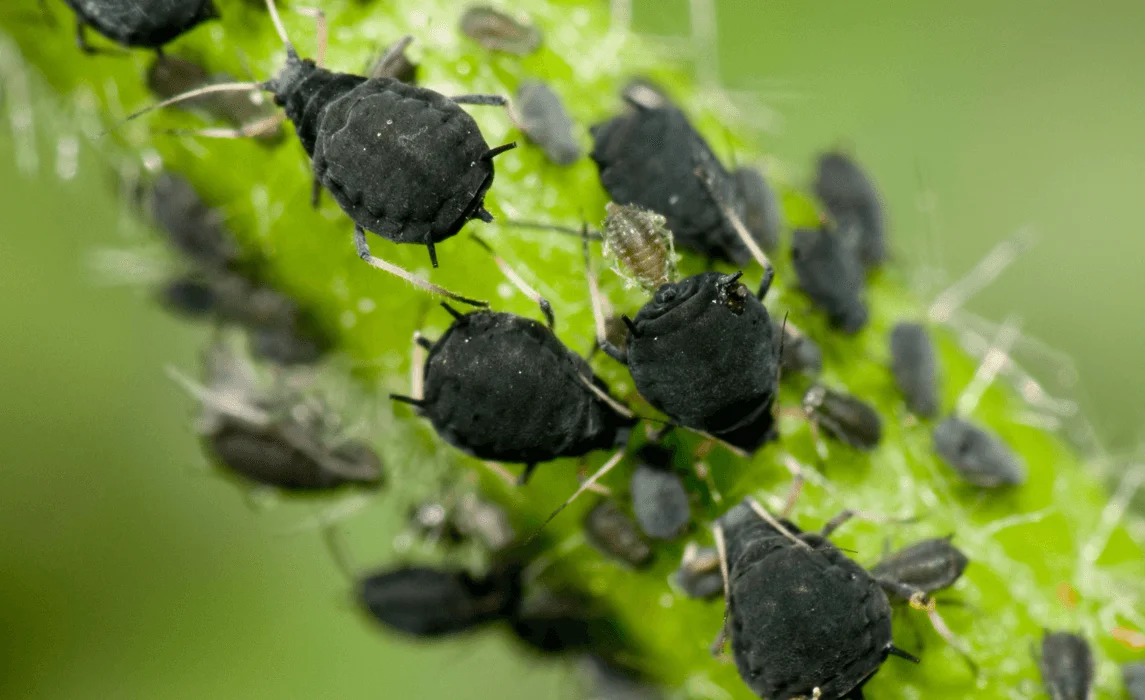
Aphids
Aphids are tiny, soft-bodied insects that suck sap from young kiwi shoots, causing curled leaves and stunted growth. To prevent aphids, regularly inspect new growth and the undersides of leaves. Encourage beneficial insects like ladybugs or use neem oil and insecticidal soap as a natural control. Keeping plants healthy and well-hydrated also makes them less susceptible to attack.
Scale Insects
Scale insects appear as small, round bumps on stems and leaves, feeding on plant sap and weakening the vine over time. Prevent infestations by pruning affected branches and applying horticultural or neem oil during the dormant season to smother eggs. Avoid over-fertilizing, as excessive new growth attracts these pests.
Spider Mites
Spider mites are tiny, spider-like pests that thrive in hot, dry conditions and cause stippled, yellowing leaves with fine webbing. Increase humidity around your kiwi vines by misting the leaves or spraying them with water to discourage mites. Regularly rinse the foliage and introduce predatory mites if infestations become severe.
Diseases
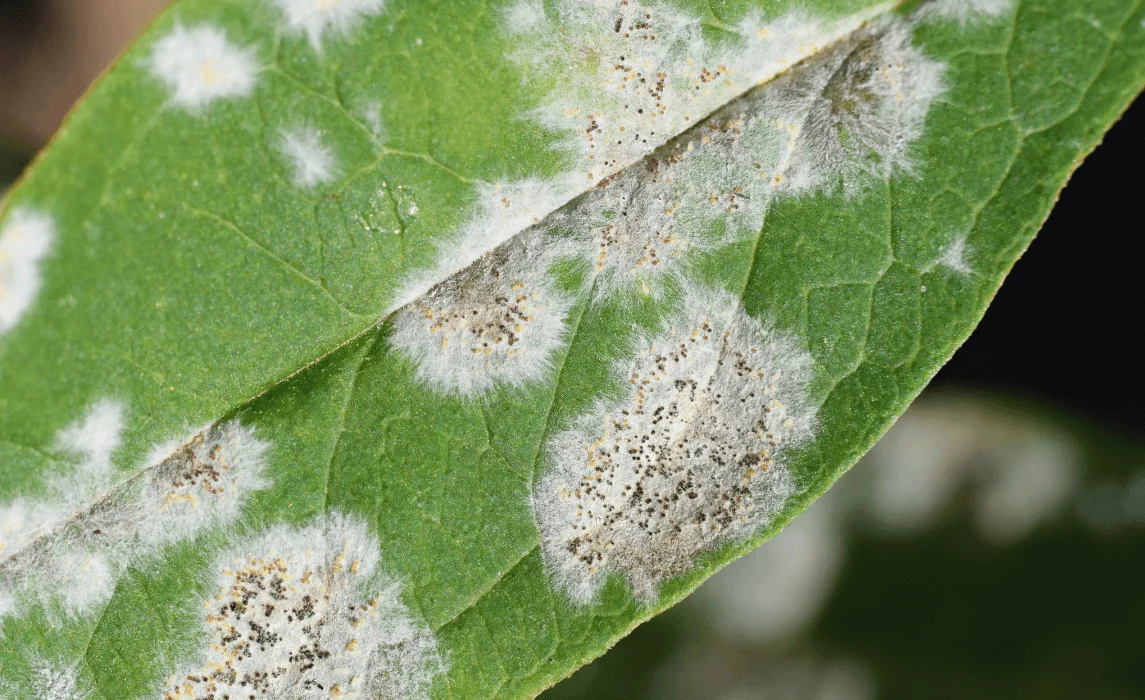
Root Rot
Root rot is a fungal disease caused by overwatering or poorly drained soil, leading to wilted leaves and decaying roots. Ensure your kiwi plants are grown in well-draining soil and avoid letting them sit in standing water. Add organic compost to improve drainage and water only when the top layer of soil is dry.
Powdery Mildew
Powdery mildew is a fungal disease that forms a white, powdery coating on leaves, hindering photosynthesis and plant growth. Prevent it by pruning vines for better airflow and watering at the base to keep leaves dry. Use organic fungicides or a baking soda spray if early signs appear.
Harvesting Kiwi Fruit When to Harvest
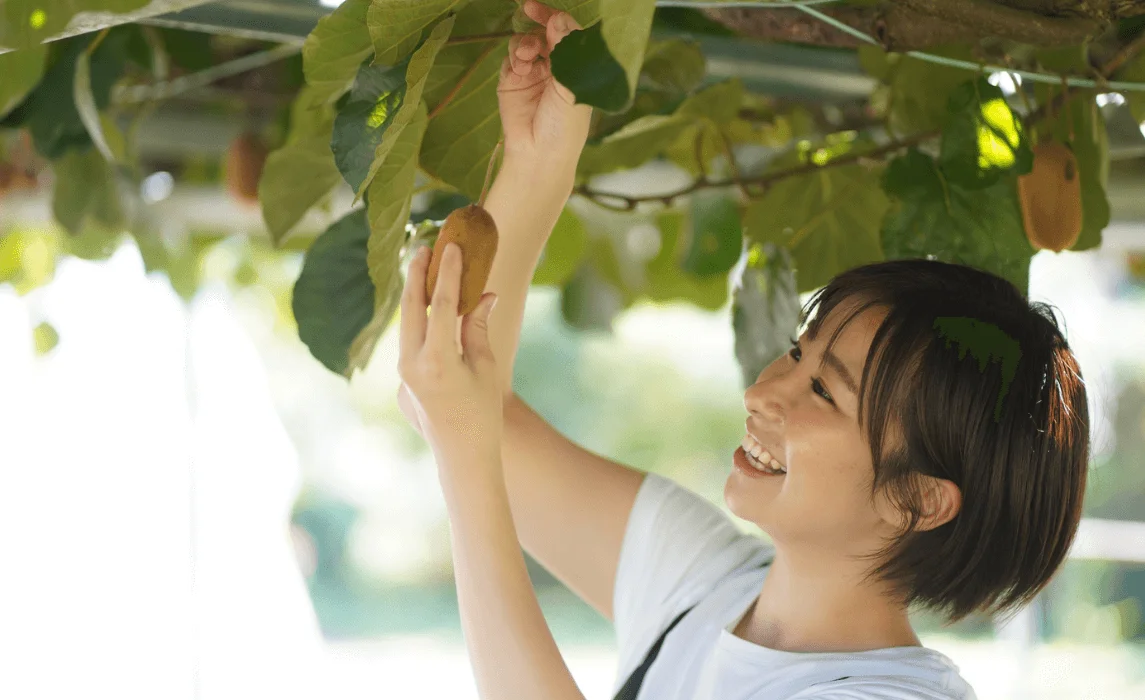
Kiwis are typically ready to harvest in late autumn, about 6–8 months after flowering. The fruit won’t ripen on the vine but should be full-sized with black seeds inside before picking. Harvest them before frost arrives while still firm, using pruning shears to cut each kiwi from the vine with a short stem. Handle the fruit carefully to avoid bruising. Unripe kiwifruit can be stored in a cool, dark place or in the refrigerator for several months. To ripen, place them in a paper bag with apples or bananas, as the ethylene gas helps speed up the process. Once ripe, they can be kept in the refrigerator for up to two weeks.
Frequently Asked Questions:
Q: How long does it take for kiwi vines to produce fruit?
A: Kiwi vines typically take 3 to 5 years to produce their first crop. If grown from seed, it may take up to 7 years.
Q: Do I need both male and female kiwi plants?
A: Yes, unless you plant a self-fertile variety. Most kiwifruit vines are dioecious, meaning male plants provide pollen, and female plants produce fruit.
Q: Can kiwi grow in cold climates?
A: Yes. Hardy kiwi varieties can withstand extremely cold winters (down to -25°C or -13°F), making them suitable for northern regions.


